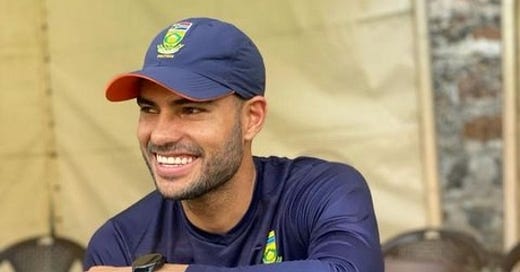Reeza Hendricks is playing a different brand of cricket. He is attacking, free-flowing and looks self-assured in almost every innings. He played in that manner in April 2019 after he was overlooked for the 2019 ODI World Cup squad. Back then he played as if he had a point to prove. Only now, Hendricks is not trying to prove a point, he is driven by a different motivation...
If you are not a subscriber of Stumped!, join more than a thousand other professional athletes & ex-pros, coaches, commentators & analysts and casual sports fans that receive the newsletter in their inbox each week — it’s free:
Word travels fast. It always has. Even in the pre-social media days, before everyone made announcements, word moved across countries with incredible speed. In 2006, shortly after Stellenbosch University made its move, word reached Corrie van Zyl that the university had offered Reeza Hendricks a hockey scholarship. Van Zyl dropped everything and drove 165 km to Kimberley.
He had one job. He had to talk to the Hendricks family.
Reeza Hendricks did not just play hockey, he loved the sport. Well, Hendricks loved sports. He grew up around people with a deep love for sports. His father played soccer. His mother recently took up running marathons and has run a few Two Oceans half-marathons. One of his uncles used to be the Springboks’ team doctor.
During his years at West End Primary School, Hendricks played soccer, hockey, tennis and cricket. He did well in all of them. It was as if the young Reeza Hendricks had taken the best out of everyone around him and made it his own. He did give everyone something to cheer for.
Northern Cape High School didn’t offer soccer and tennis, so he only continued with hockey and cricket. Focussing on two sports made Hendricks even better. He grew into an irreplaceable centre link in hockey. In cricket, Hendricks was outstanding. That’s how Corrie van Zyl first got to know of Reeza Hendricks, people he knew from Kimberley were raving about an exceptional young cricketer from Kimberley.
Van Zyl did not waste time before having a look at the youngster. He was impressed. And now, cricket was about to lose that promising youngster to hockey. Van Zyl’s one job, as he sat across from Hendricks and his parents, was to convince them that the teenager would do well to pick cricket over hockey.
“My pitch was that Reeza had a better chance of a professional career playing cricket than he did playing hockey. Cricket was now a professional sport, and so he was more likely to make a career out of cricket compared to hockey. Hockey was not yet a professional sport back then,” says van Zyl.
Over a hundred thousand youngsters take part in KFC's mini-cricket program. Each with a dream of their own. Only about 1% of those kids play in the Khaya Majola Coca-Cola Week. Only 16 of them get selected for the South Africa Under-19 team. Only a select few from the Coke Week teams play professional cricket. Even less get to play for the Proteas. It was a gamble 17-year-old Reeza Hendricks and his parents were willing to take after listening to Corrie van Zyl.
A few days later, he was an Eagles player.

This Substack column exists thanks to patrons and readers that leave tips. Stumped! is wholly supported by Readers Like You. To keep the weekly posts coming and keep the lights on here, consider leaving a tip or supporting monthly on Patreon. You won’t regret it!
Don’t forget to share the post with friends.
Reeza Hendricks preferred to wear the number seven jersey. He had carried that number on his back for as long as he could remember. Hendricks wore number seven in primary school. He wore number seven in high school. He wore number seven when he played for William Pescod Hockey Club.
Tabraiz Shamsi wears the number 26 jersey because he was 26 when he made his international debut. 26 also happens to be his wife’s birthday, so everything just ties in beautifully for him and the number. Most cricketers choose a jersey number that has a deep meaning in their lives; a birth year, birth date or an important date.
On 29 June 2003, Jacques Kallis debuted his number 65 ODI shirt. The Proteas were part of a NatWest triangular series that featured England and Zimbabwe in England. Kallis’ then-65-year-old father was battling lung cancer. It was Kallis’ way of showing support to his ailing parent. Then, of course, some cricketers like cheeky shirt numbers like 69.
Reeza Hendricks does not have a deep reason why he has always loved the number seven. He has just always loved it. If you press him hard enough, he might tell you that it is because seven is the number of perfection.
When he got to the Eagles, Hendricks could not carry the number seven on his back because that shirt belonged to Ryan Bailey. Hendricks was 17 years old, and 17 has a seven, so he chose 17. He has carried that shirt number since then. Hendricks did wear the number seven until he was 21. That’s when he stopped playing hockey.
Now Reeza Hendricks has a new favourite number: 64.
There is no telling if he will do what Kallis did with the number 65 and wear the number 64 for one match or a series, but it is a number that has made a huge difference to his career. For the time being, the number is written on his thigh pad.
According to Corrie van Zyl, how well Reeza Hendricks executes his shot over extra cover tells you a lot about how he will play that day. "When he arrived at the Eagles, Reeza played conservatively, but once he settled in he played with freedom. He has one of the most exquisite shots over extra cover when he is flowing," says Corrie van Zyl.
Hendricks has been executing the shot with perfection since the day he wrote the number on his thigh pad.
Geoffrey Toyana says one way to tell if Reeza Hendricks is in good rhythm is to look at his foot movement. If it is crisp from the first over he faces, Hendricks will be a menace to bowlers. His foot movement has been on point in his last 14 T20 innings since the CSA 50-over final. In the match, Hendricks led the Lions to victory over the Titans with an impressive 157-run knock. He also took a single wicket, one for 28 in five overs. The match was played on 6-4-2022.

April the 6th is the day when Callum Hendricks, Reeza Hendricks’ son, was born. Hendricks dedicated that innings to Callum. Callum Hendricks has been the inspiration behind Hendricks’ transformation. Since the birth of his son, Hendricks has experienced a shift in identity. His identity is no longer tied to how well he performs on the field.
*In early 2021, I tried to have an interview with Hendricks as part of my DebuTons series, a series of batters who scored a century on debut. He scored a century on his ODI debut. People close to him advised me that the timing was off because Hendricks had had a bad run with the bat. He felt as if he had let everyone down when he did not do well.
Between 2004 and 2009, two researchers looked at the putting tendencies of 421 golfers in more than 239 tournaments on the PGA tour. They found that when the majority of golfers tried to make a birdie, they were less successful compared to when they lined up the exact same putt for par.
Professors Devin Pope and Maurice Schweitzer noted that during any putting attempt, strokes for birdie were softer and less accurate than strokes for par. Ultimately, players “sacrifice success when putting for birdie to avoid difficult follow-up putts”.
They did not take risks. Instead of playing with freedom, they restricted themselves to simply doing just enough to keep them in the game. In cricket, as in golf, players do not play to their full potential if they approach the game tentatively.
Before Callum’s birth, Reeza Hendricks restricted himself to trying to not lose his wicket. He worried about whether he would be selected again if he fell cheaply, so he played it safe. Hendricks punished the bad balls and did just enough against good deliveries. Hendricks did not feel as if he had the freedom to express himself.
In 2009, Tiger Woods faced off with Y. E. Yang, a 37-year-old unknown quantity. Many golf fans will remember the astonishing outcome, Yang defeated Woods to win a Major and earn himself the nickname The Tiger Killer. Yang, literally romped to victory while the cautious Woods pocked and prodded himself to a loss.
For Yang, the entire round was a putt for par. He had nothing to lose. Yang went for the pin every time. Woods, on the other hand, retreated into himself. He played the game with a “Don’t mess this up” mindset. The whole match against Yang was a birdie putt for Tiger Woods. At international level, most of Hendricks’ innings were a series of birdie putts. Hendricks played afraid of messing up, so he did not trust his skills and flair.
Callum has changed all that. Whether the runs come or not, Hendricks is now playing an attacking brand of cricket. Since Callum’s first birthday, Hendricks has averaged 64.66 runs at a strike rate of 188.34 in T20s for SA A. He has also averaged 46.14 runs at a strike rate of 138.48 for the Proteas. Reeza Hendricks the stroke player has finally made it to the Proteas because of Callum Hendricks.
He is playing fearless cricket. He is enjoying the game.
On July 27, 2022, Hendricks scored 53 runs from 32 balls to help South Africa win against England. He dedicated that innings to Callum. “He (Hendricks) just wants to make Callum proud even though he doesn’t understand the game yet. He watches the matches and recognizes Reeza. The only way he can do that is by giving his all, holding nothing back, for the team,” says Lee-Ann Hendricks.
Callum Hendricks has helped his father find something bigger and more important than cricket. He has helped his father discover his new favourite number; number 64. He also helped Reeza Hendricks rediscover the magical spark that many people saw in him when he was rising through the ranks.





